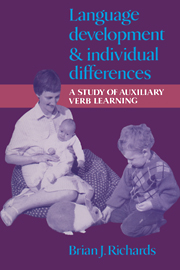Book contents
- Frontmatter
- Contents
- List of figures
- List of tables
- Preface
- Symbols used in transcription
- Pronunciation table
- PART I INTRODUCTORY SECTIONS
- PART II INDIVIDUAL DIFFERENCES AND AUXILIARY VERB LEARNING IN SEVEN CHILDREN
- 3 Research design
- 4 Rate of development
- 5 Indicators of analytic and piecemeal learning
- 6 The complexity principle as an indicator of holistic learning
- 7 Individual differences and the development of auxiliaries in tag questions
- 8 The development of auxiliary DO
- 9 The development of CAN
- PART III ENVIRONMENTAL INFLUENCES AND INDIVIDUAL DIFFERENCES IN AUXILIARY VERB LEARNING
- Notes
- References
- Index
3 - Research design
from PART II - INDIVIDUAL DIFFERENCES AND AUXILIARY VERB LEARNING IN SEVEN CHILDREN
Published online by Cambridge University Press: 19 September 2009
- Frontmatter
- Contents
- List of figures
- List of tables
- Preface
- Symbols used in transcription
- Pronunciation table
- PART I INTRODUCTORY SECTIONS
- PART II INDIVIDUAL DIFFERENCES AND AUXILIARY VERB LEARNING IN SEVEN CHILDREN
- 3 Research design
- 4 Rate of development
- 5 Indicators of analytic and piecemeal learning
- 6 The complexity principle as an indicator of holistic learning
- 7 Individual differences and the development of auxiliaries in tag questions
- 8 The development of auxiliary DO
- 9 The development of CAN
- PART III ENVIRONMENTAL INFLUENCES AND INDIVIDUAL DIFFERENCES IN AUXILIARY VERB LEARNING
- Notes
- References
- Index
Summary
Rationale
Chapter 2 showed that the rate at which children developed rule-based usage of the auxiliary was not independent of other aspects of syntactic development and that measures of rate of learning could be unduly influenced by children's learning styles, sampling and transcription error, and the set of verbs included. The work also demonstrated the difficulties of identifying rule-based usage, especially in relatively small language samples recorded at infrequent intervals.
In this section a more intensive longitudinal study of auxiliary verb learning in seven children is described. The study combines larger samples of spontaneous speech collected at shorter intervals and is supplemented by an elicitation task which attempts to overcome the problem of sampling less commonly used verb forms. The rationale for identifying unanalysed units is based on MacWhinney (1982, pp. 76–83). From an extensive survey of the literature, MacWhinney evaluates fourteen types of evidence that can indicate rote-learning. Those most relevant to the current investigation are the following:
Dual- or multimorpheme structures with a single intonational unit (to this we will add the condition that the intonation pattern is invariable).
Producing the whole phrase before the separate components.
Producing contracted forms before full forms.
The production of ‘precocious strings’.
Redundancy errors, such as # ‘What's is it?’.
Of MacWhinney's indicators, items 2, 3 and 4 all derive from the relationship between complexity and sequence. If other factors are held constant, acquisition proceeds in a sequence which corresponds with syntactic complexity (Block and Kessel, 1980; Brown, 1973; Brown and Hanlon, 1970; Pinker, 1981; De Villiers and De Villiers, 1973).
Information
- Type
- Chapter
- Information
- Language Development and Individual DifferencesA Study of Auxiliary Verb Learning, pp. 29 - 43Publisher: Cambridge University PressPrint publication year: 1990
